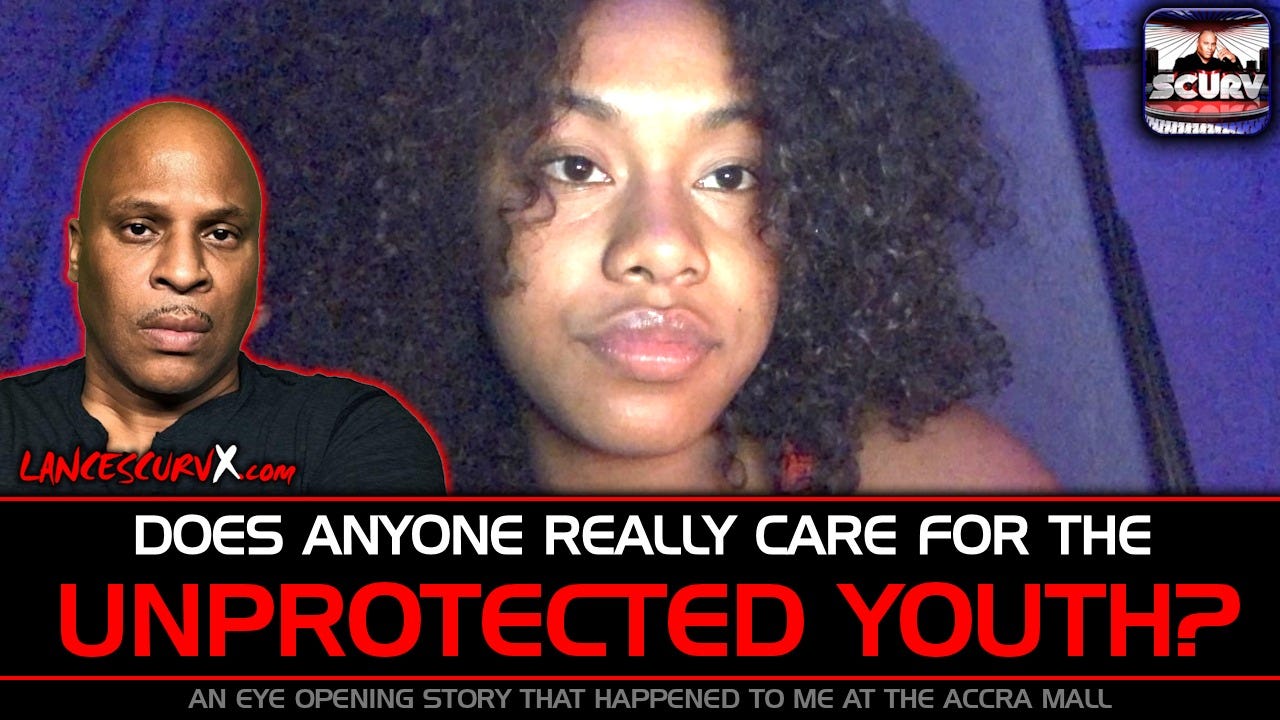DOES ANYONE REALLY CARE FOR THE UNPROTECTED YOUTH?
We like to believe children are safe in the places they should be — in their homes, in their families, with the people they trust. But the terrifying truth is that some of the greatest threats to children come from exactly those places. Child molestation is not just a problem “over there” in other countries; it’s a crisis everywhere, including in the United States, and here in Ghana, near Accra where I currently reside. The people who hurt children are often people the children, and their families, trust: family members, friends, mentors. They use trust as their weapon.
This discussion is not just about exposing a problem. It’s about understanding how these predators work, why abuse often stays hidden, and what the lifelong damage is when young people are robbed of their innocence. We have to talk about grooming, denial, power dynamics, and the trauma that lasts well into adulthood.
The Scale of the Problem in the United States
Because many in my audience are from the U.S., it’s important to highlight how serious the issue is there too — not just here in Ghana.
According to the U.S. Department of Health & Human Services, in fiscal year 2023, 546,159 children were reported as victims of abuse or neglect in the United States, which equates to a national rate of about 7.4 victims per 1,000 children. Administration for Children and Families
In that same 2023 report, around 2,000 children died from abuse or neglect, a rate of about 2.73 per 100,000 children. Administration for Children and Families
Sexual abuse is a significant portion of this. Estimates indicate that 1 in 4 girls and 1 in 20 boys in the U.S. experience child sexual abuse before they turn 18. CDC+1
Per the National Children’s Alliance, in 2022 there were 558,899 unique incidents of abuse and neglect confirmed. National Children’s Alliance+1
In terms of perpetrators, about 76% of children in substantiated abuse cases were victimized by a parent or legal guardian, highlighting how often abuse comes from within the home. National Children’s Alliance
Even more alarming: nearly 90% of sexual abuse cases involve someone the child or their family knows and trusts (a family member, friend, or other close person). Stop It Now+1
Many survivors never disclose the abuse in childhood — less than 40% of victims tell someone while still children. Stop It Now
On a generational scale, it’s estimated that tens of millions of Americans are survivors of childhood sexual abuse. Some sources say around 60 million U.S. adults report having experienced sexual abuse when they were young. Stop Child Exploitation
These figures show that child sexual abuse is not a fringe issue: it’s a deeply entrenched problem, even in a country as wealthy and institutionally developed as the U.S.
The Scale of the Problem: How Big Is This Crisis (Global + Ghana)
According to UNICEF, more than 370 million girls and women alive today experienced rape or sexual assault before turning 18. Child Safety Center
When you add non-contact forms of abuse — such as verbal harassment, exposure to pornography, or online solicitation — that number rises to 650 million, or about 1 in 5 globally. Child Safety Center
In sub-Saharan Africa, the numbers are especially strong: over 79 million girls and women say they were sexually abused as children. Child Safety Center
Here in Ghana, the problem is also grave: in one recent period, around 22,000 instances of child sexual-abuse material were accessed, shared, or produced in Ghana. Sokolove Law
Between 2023 and 2024, 45,409 child sexual abuse materials (CSAM) were found to have circulated in Ghanaian cyberspace. Statista+1
Experts have also warned that boys are increasingly at risk: according to pediatric and social development specialists in Ghana, “one in 20 boys” may experience sexual abuse — a number that is likely underreported. Statista
These numbers are not just statistics. They tell us that this is not a rare or isolated problem. It is widespread, and children we know — in our neighborhoods, in our churches, in our families — are vulnerable.
How Predators Operate: The Psychology and the Patterns
To begin to understand why child molestation persists, we must understand how predators think and operate. These are not random attacks. Predators are often patient, manipulative, and highly strategic.
Selection
Predators pick children who seem compliant, trusting, or isolated, or who have low self-esteem.Building Access and Isolation
They create opportunities to be alone with the child. This may involve “innocent” activities: mentoring, gifts, trips, or simply spending time.Gaining Trust
These adults present themselves as kind, charming, and helpful. They give attention, affection, and often a kind of emotional validation that the child may not otherwise get.Desensitization
Touch that seems harmless at first (“just a hug,” “a pat on the back”) becomes more sexual over time. They gradually erode the child’s boundaries.Maintenance / Post-Abuse
Even after crossing the line, predators work to keep control: through guilt, threats, shame, or by reinforcing secrecy. Some even maintain grooming behaviors long after the first abusive act.
Grooming is not a one-time thing. According to studies of survivors, many report experiencing multiple grooming behaviors before any abuse occurs.
Why Families Deny or Refuse to See
One of the most heartbreaking parts of this crisis is how often abuse is ignored, denied, or covered up — especially when the abuser is a family member or a trusted friend.
Shame and stigma. Parents or older family members might feel ashamed, believe the child is lying, or fear social judgment if the abuser is known.
Cognitive dissonance. It’s much easier for someone to deny than to admit that a trusted person could do something so evil.
Power dynamics. Many abusers are in positions of authority: older relatives, church leaders, or community figures. Victims, especially young ones, may not feel they have power.
Lack of belief. Sometimes, even when a child speaks up, they are dismissed because “children lie” or “you must be misunderstanding.”
Silence as protection. Families may believe that keeping it quiet protects them from scandal — or that confronting it will damage the family, more than leaving it hidden.
This silence gives predators space. If their behavior is never questioned, they continue, unchallenged.
The Lifelong Impact on Survivors
When children are abused, the damage doesn’t end at childhood. The trauma carries over into adulthood in ways that deeply shape their lives.
Mental Health
Survivors often struggle with depression, anxiety, post-traumatic stress disorder (PTSD), or dissociation. The impact can last decades.Trust and Relationships
Someone who was betrayed by someone they trusted may find it hard to trust later. They can push people away, or alternatively, they may be drawn into unhealthy relationships.Sexuality and Behavior
Early, coercive sexual experiences can distort how survivors view sex. Some shut down entirely; others may become promiscuous or engage in risky sexual behavior.Self-Worth
Many survivors feel broken, worthless, or damaged. Abusers often condition children to keep secrets, which can lead to shame that stays hidden for years.Longevity of Trauma
Without support, survivors might internalize the abuse as part of their identity. This can affect career, social life, parenting, and how they see themselves in the world.
Why the Problem Persists — Even Now
Online exploitation is exploding. Predators are using the internet, social media, and gaming platforms to groom kids.
AI and technology make it worse. There are growing concerns that artificial intelligence tools could be used to facilitate grooming.
Low reporting. Many cases go unreported because children are afraid, families are in denial, or systems don’t support victims well.
Cultural barriers. In many communities, talking about sex and abuse is taboo. Denial is easier than action.
Resource gaps. Even when abuse is reported, there may not be enough trained counselors, child protection services, or legal follow-through to help the child heal — or to hold the abuser accountable.
What Can Be Done
Education & Awareness
Teach children about boundaries, consent, and what “safe touch” means.
Train parents, caregivers, teachers, and community leaders to recognize grooming signs.
Use public campaigns to break the stigma around speaking up.
Safe Reporting Channels
Set up helplines, child-friendly reporting mechanisms, and whistleblower protections.
Equip schools, police, and social services to handle abuse reports sensitively and effectively.
Support for Survivors
Provide trauma-informed counseling, especially for young people.
Offer long-term mental health support, not just immediate crisis care.
Create peer support groups where survivors can share, heal, and reclaim their stories.
Stronger Laws & Enforcement
Push for more effective child protection laws.
Advocate for cross-border cooperation in online abuse investigations.
Increase prosecutions of abusers and hold platforms accountable for grooming activity.
Community Accountability
Families, religious institutions, and traditional leaders must refuse to look away.
Communities should empower children, not silence them.
Adults must ask themselves: Do we really care for the unprotected youth?
FINAL THOUGHTS
“Does Anyone Really Care for the Unprotected Youth?” — This is not just a rhetorical question. It’s a challenge to all of us. When we turn our faces away, we give predators the power to continue. When we speak up, support survivors, and demand change, we give children a fighting chance.
If you are listening right now, and you’ve been hurt, you are not broken. You are not alone. And what happened to you does not define you. Healing takes time, but your voice matters. Your story matters.
For those of us who have the power — as parents, as community members, as leaders — we must do more than care in private: we must act in public.




